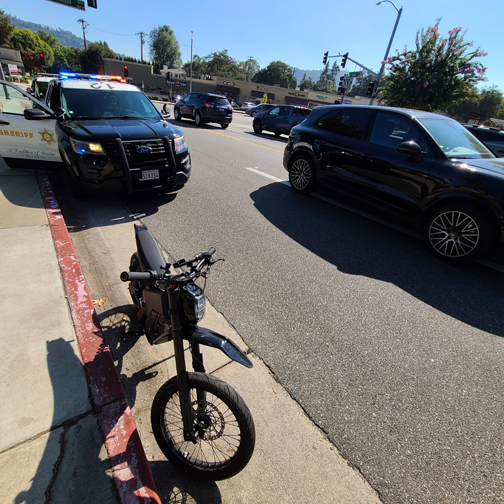
Photo by Mary O’KEEFE
By Mary O’KEEFE
“In collaboration with the Crescenta Valley Station [CV-LASD], the City of La Cañada Flintridge will begin increased education outreach and enforcement efforts aimed at enhancing e-bike safety and compliance with local laws,” stated the City of La Cañada Flintridge.
The issue of e-bikes and e-motorcycles has been something city officials and law enforcement have been dealing with – not only in La Cañada Flintridge but also in other areas of the Crescenta Valley. In a recent meeting among Sunland-Tujunga residents and Los Angeles police, residents expressed concerns about those riding these vehicles at high rates of speed or ignoring traffic issues.
La Cañada Flintridge has seen an increase in youth riding e-motorcycles on streets and sidewalks in the City.
“The e-motorcycles are not street legal vehicles,” said Sgt. John Gilbert, CV-LASD. He added the issue of teenagers driving a powerful vehicle and “popping wheelies” and other unsafe actions are cause for concern. CVW was contacted by readers who witnessed e-motorcycles and e-bikes driven erratically.
There is a difference between e-bikes and e-motorcycles. E-bikes, or electric bikes, are designed to look like a traditional bicycle with pedals and handlebars. E-bike speeds can reach up to 30 miles per hour and are designed to assist riders while they pedal. E-bikes must follow laws that are similar to standard bicycles though e-bikes are exempt from some California laws including requiring an operator’s license and having state or local registration, motor vehicle insurance or license plates.
The California vehicle code defines e-bikes as: “[A] bicycle equipped with fully operable pedals and an electric motor of less than 750 watts.” It further breaks e-bikes into three categories, following a classification system created by PeopleForBikes that has been adopted in 40 states: Class 1: Provides assistance only when the rider is pedaling and ceases to provide assistance when the bicycle reaches a speed of 20 mph. Class 2: Operates via pedal-assist or throttle and ceases to provide assistance when the bicycle reaches a speed of 20 mph. Class 3: Provides assistance only when the rider is pedaling and ceases to provide assistance when the bicycle reaches a speed of 28 mph, according to calbike.org.
The main issue with e-motorcycles that have been seen on the streets in the area is that they are not legal street vehicles. They are more like a type of mini bike or dirt bike, although they are electric powered.
“They do not have VIN [vehicle information numbers], correct lighting or reflectors,” Gilbert said.
These e-motorcycles can reach speeds up to 70 mph, and may require an M1 driver’s license.
There are penalties for riding these e-motorcyles, including having the vehicle confiscated by law enforcement.
Gilbert added the focus of the e-bike safety campaign is to educate residents about the laws and the difference between e-bikes and e-motorcycles.
According to the statement: Over the next few weeks, the City will roll out an informative social media campaign designed to educate the community about the various classes of e-bikes, scooters and e-motorcycles. These posts will clarify the distinctions between different types of electric vehicles and outline the specific regulations that apply to each category. Additionally, the campaign will emphasize crucial rules of the road and provide practical safety tips for riders.
The initiative will also address the legal and financial consequences of violating e-bike regulations. By highlighting these potential repercussions, the City and the Crescenta Valley Sheriff’s Station aim to deter non-compliance and promote responsible use of electric mobility devices.
As part of this effort, Crescenta Valley Sheriff’s Station deputies will increase enforcement of e-bike-related laws. Deputies will be on the lookout for illegal use of e-bikes and e-motorcycles, particularly among students commuting to and from school. In collaboration with local school districts, the station will work to ensure that students adhere to legal requirements and maintain safety standards.
